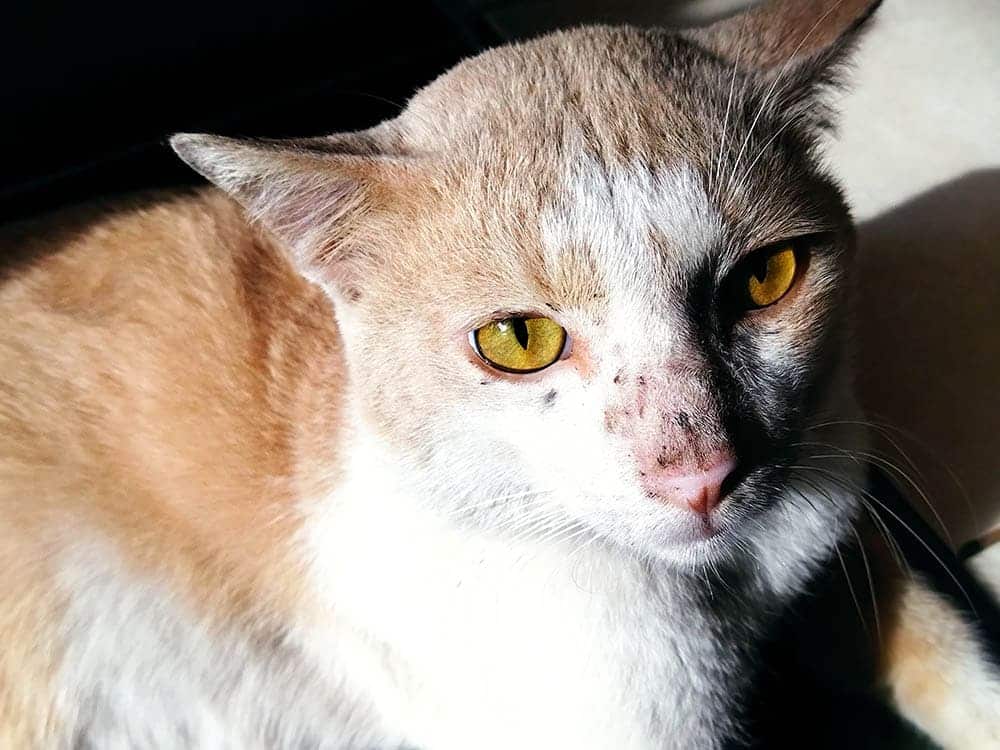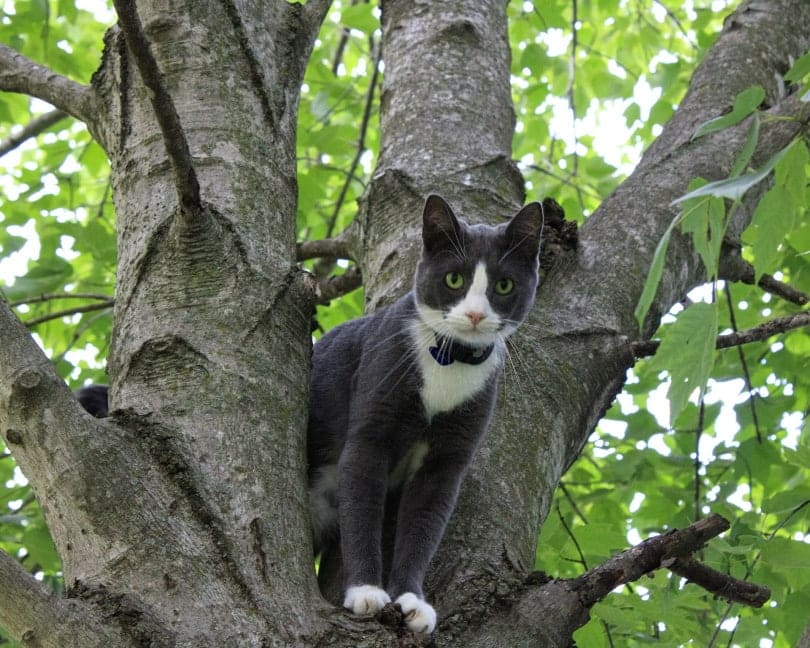Click to Skip Ahead
We could all do with a bit of fun in our lives, and although naming your cat is a very serious task, there’s nothing better than being reminded of your favorite pirate story, pirate-related feature, or fictional character on a daily basis.
We’re all different, and what may seem too bold for you may be the perfect name for someone else, so we’ve gone ahead and listed them all—from subtle to outrageous, just like pirates themselves.
Take a look at these pirate names for your cat. Maybe you’ll be inspired to use one for your swashbuckling cat!

How to Name Your Cat
There are many ways to go about coming up with a name for your cat, and we think it’s important to match a name with your cat. Giving your cat a random name won’t make it personal, and you may end up hating it after a bit of time. Here’s one of the ways that we go about naming our cats.
Consider Their Backstory
What is your cat’s history? Have you just purchased a kitten or adopted an older cat from a shelter?
We’ve found that kittens suit softer, sweeter names, whereas older cats that have been around the block a bit suit stronger, tougher names that go hand-in-hand with the life experiences they’ve had to endure. Although not always the case, a sweet name, such as Will, seems to suit a new kitten, and a tougher name, such as Captain Blackbeard, may suit an older cat.

Consider Their Appearance
Appearance is a key factor when it comes to naming your cat. If your cat is dark in color, a pirate name such as Captain Black Jack might be fitting, while a lighter cat would suit Captain Silver-Tongue well. A cat full of patches can affectionately be named Ruth O’Patches.
Cats that have miraculously made it through health issues, attacks, or who have been born differently should be confident and proud of their differences. These types of cats stand out and shine, and their names can do the same. A cat with one eye can boast a cool name like One-Eye Wendy, and cats lacking a few teeth can boldly display the name One-Tooth John.
But of course, if a name resonates with both you and your cat, they’ll do the name justice no matter what they look like.
List Them and Narrow It Down
Go through several lists of pirate name ideas and write down the ones you enjoy most. Try calling your cat by your favorite names and see how they respond and whether you can associate the name with your cat.
As you move through this method, scratch off the names that you like a little bit less than the others, and eventually, you’ll end up with only a few that you can ask for your friends and family’s opinions on. After a bit of time, you’ll know which one stands out to you most—and that’ll be the right name for your beloved swashbuckling cat.
Historical Pirate Names
Having a love for pirate stories doesn’t mean that you’re limited to being a Pirates of the Caribbean fan. There were many real-life pirates that sailed the seas throughout history, and they have fascinating stories. Listed below are the names of pirates, along with the years they were active, so that you can give your friends a few facts when they ask about your cat’s name.

Male Pirate Names
- Gan Ning (190–197)
- James Alday (1516–1576)
- John Crabbe (1305–1332)
- Cord Widderich (1404–1447)
- Samuel Axe (1629–1645)
- Sir Andrew Barton (1466–1511)
- Jambe de Bois (1550s–1560s)
- Sir Francis Drake (1540–1596)
- Piers Griffith (1568–1628)
- Sir James Lancaster (1591–1603)
- Peter Love (1590s–1610)
- William Parker (1590s–1600s)
- Sir George Somers (1595–1607)
- John Ward (1603–1610s)
- Wang Zhi (1551–1555)
- Jean Bart (1672–1697)
- John Bear (1684–1689)
- Lancelot Blackburne (1680–1684)
- George Bond (1683–1684)
- James Browne (1676–1677)
- Nicholas Clough (1682–16830
- Edmund Cooke (1673–1683)
- Jacob Fackman (1662–1666)
- Philip Fitzgerald (1672–1675)
- Thomas Freeman (1655–1680)
- Michel de Grammont (1670–1686)
- Red Legs (1670s–1690s)
- Richard Hawkins (1593–1594)
- Sir Henry Morgan (1663–1674)
- John Morris (1663–1672)
- Bartholomew Sharp (1679–1682)
- Gustav Skytte (1657–1663)
- Charles Swan (1679–1682)
- Lionel Wafer (1679–1688)
- Leigh Ashworth (1716–1719)
- Thomas Barrow (1702–1718)
- Edward Teach (1716–1718)
- Black Caesar (1700s–1718)
- Phineas Bunce (1717–1718)
- Captain Crapo (1704–1708)
- Captain Davy (1704–1705)
- Henry Avery (1694–1699)
- Israel Hands (1700s–1718)
- Benjamin Hornigold (1717–1719)
- Captain Kidd (1695–16990
- Old Captain Crackers (1704–1721)
- Captain Napin (1717–1718)
- Amaro Pargo (1703–1737)
- Major Penner (1710s)
- Calico Jack (1683–1694)
- Blackbeard (1716–1718)
- Black Bart (1719–1722)
- Tempest Rogers (1693–1699)
- Jasper Seagar (1719–1721)
- Ralph Stout (1692–1697)
- Captain Thompson (1719)
- Turn Joe (1717)
- Louis-Michel Aury (1810–1821)
- Pugsy Hurley (1865–1886)
- Sam Hall Lord (1800s–1840s)
- Alcantara (1820s)
- Don Pedro Gilbert (1832–1834)
- Eli Boggs (1830–1857)
Female Pirate Names
- Jeanne de Clisson (1300–1359)
- Grace O’Malley (1560s–1600s)
- Anne Bonny (1718–1720)
- Mary Read (1708–1721)
- Flora Burn (1740s–1750s)
- Sadie The Goat (1869)
- Rachel Wall (1781–1782)
- Anne Dieu-le-Veut (1600s)
- Madame Ching (1805–1810)
- Lady Killigrew (1540s–1587)
Pirate-Related Names
Olden-day pirate names are interesting but might be a bit too serious and human-like for some cat owners. Sometimes, the quirkier names come from pirate-related objects, people, foods, and drinks. A link between your cat and pirates is often all you need to come up with a great name.
- Grog
- Jolly Roger
- Patches
- Peg
- Grampus
- Clipper
- Billy Bones
- Barnacle, or Barney for short
- Cotton
- Sailor
- Cannonball
- Bailer
- Anchor
- Lassie
- Lady
- Captain
- Booty
- Treasure
- Shanty
- Dirk
- Matey
- Rum
- Seadog
- Loot
- Cargo
- Rain
- Jewels
- Legend
- Musket
- Ocean
- Parley
- Scar
- Thug
- Bay
- Coral
- Storm
- Wave
- Flora
- Fury
- Shadow
- Harbor
- Atlantis
- Skully
- Winter
- Summer
- Nasty
- Olive
- Rainbow
- Redd
- Rivers
- Scrappy
- Skip
- Cooper
- Navi
- Bosun
- Sails
- Grub
- Burgoo
- Loblolly
- Spirits
- Seabiscuit
- Gunner
- Blimey
- Buccaneer
- Chase
- Chantey
- Brisket
- Cog
- Hearties
- Killick
- Maroon
- Mizzen
- Plunder
- Bow
- Scallywag
- Savvy
- Squiffy
- Tar
- Wench
- Dungbie
Pirate Name Inspiration From Movies
Most of the pirate names we can list out of our heads come from movies that are based on a real pirate that lived long ago or ones that were completely made up. Either way, the movies generally have really cool, funny, or strong names that are great options for your furry companion, whether they’re pirates or other characters.

Treasure Island
- Billy Bones
- Livesey
- Captain Smollett
- Gunn
- Pew
Hook
- Pan
- Captain Hook
- Tinker Bell
- Smee
- Wendy Darling
- Rufio
- Ace
- Tootles
- Pockets
- Thud Butt
The Adventures of Tintin
- Tintin
- Captain Haddock
- Snowy
- Wolff
- Wagg
- Tapioca
- Unicorn
- Red Rackham
Pirates of the Caribbean
- Barbosa
- Jack Sparrow
- Will
- Swann
- Gibbs
- Carina
- Beckett
- Davy Jones
- Norrington
- Salazar
- Weatherby
- Bellamy
- Groves
- Marty
- Kraken
- Tia
- Ferdinand
- Jacoby
- Marina
- Mercer
- Ogilvey
- Old Bill
- Bootstrap
- Spaniard
Treasure Planet
- Long John Silver
- Amelia
- Scroop
- Doppler
- Mr. Arrow
- Morph

The Pirates! In an Adventure with the Scientists!
- Hastings
- Colingwood
- Scarlett
Pan
- Barnabas
- Bishop
- Nibs
The Black Swan
- Denby
- Wogan
The Goonies
- Chunk
- Perkins
- Chester
The Buccaneer
- Flint
- Peavey
- Rumbo
- Phipps
- Bonnie

Captain Kidd
- Povey
- Bartholomew
- Rawson
- Lorenzo
Nate and Hayes
- Hayes
- Sophie
- Beck
- Count
Cutthroat Island
- Shaw
- Ainslee
- Blair
- Scully
- Trotter
- Bowen
- Mordechai
The Princess and the Pirate
- Sylvester
- Margaret
- Featherhead
- Barrett
- Pedro
- Pelly
- Alonzo
Castle in the Sky
- Pom
- Pazu
- Dola
- Louis
- Madge
- Motro
- Mouro
The Boy and the Pirates
- Snipe
- Abu
- Scoggins
- Peake
- Mr. Warren
The Pirate
- Mabel
- Stanley
- Ruth
- Samuel
- Edith
- Isabel
Against All Flags
- Hawke
- Spitfire
- Roc
- Patma
- Molvina
- Gow
- Harris
- Moisson
- Hornsby
- Barber
- Hassan
Captain Blood
- Bishop
- Jeremy
- Bronson
- Willoughby
- Ogle
- Barlow
- Gardner
- Baynes
- Diego
- Kent
- Steed
- Lord Sunderland

Muppet Treasure Island
- Gonzo
- Zoot
- Rizzo
- Beaker
- Piggy
- Pepper
- Roach
- Sweetums
A High Wind in Jamaica
- Chavez
- Emily
- Rosa
- Mathias
- Thornton
- Marpole
- Benito
- Curtis
- Tallyman
- Alberto
The Ice Pirates
- Jason
- Roscoe
- Zeno
- Patch
- Wendon
- Maida
- Hymie
Other Fictional Pirates
- The Black Pirate
- Captain Blood
- Captain Clegg
- Captain Kennit
- Captain Horatio McCallister
- Captain Jack Dancer
- Captain Walker D. Plank
- Captain Pugwash
- Gunpowder Gertie
Fun Pirate Name Ideas
Basing your cat’s name off pirates, pirate movies, and pirate-related things is fun, but what’s more fun is creating pirate names of your own. You can come up with your own pirate name for your cat by starting it with “Captain”, a pirate feature, or by using an already listed pirate name and then adding a few features that your cat has to the name.

Below are a few fun examples.
- Captain Patches
- Henry Hook
- Cannonball Cody
- Captain Black Coat
- Red-Locks Lolly
- Captain Wild
- Mittens Gun-Powder
- One-Leg Ginger
- Captain Loud Meow
- Captain One-eye
- Captain Puffypants
- Grace Gold-Tooth
- Captain Booty Boy
- Captain Longtail
- Shanty Sharptooth
- Nancy Tall-Tide
- Big Jones
- Old Chipper
- Misty Winters
- Lady Tide
- Sea Hawk
- Captain Phillips
- Black Cat the Feared
- Admiral Ocean
- Trixie Tuna-Breath
Conclusion
You’ve got a lot of pirate names to consider after reading through these lists. You’ll be calling your cat by their name for the rest of their lives, so make sure it’s a name you really like, whether it’s funny, serious, reminds you of your favorite historical pirate, or matches your pirate-looking furry friend!
See also:
- 160 Cat Names That Start With H: Fun & Creative Options
- 250 Cat Names That Start With K: Chic & Creative Options
Featured Image Credit: Benevolente82, Shutterstock














